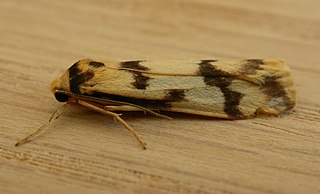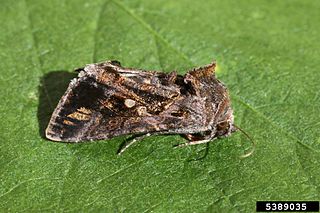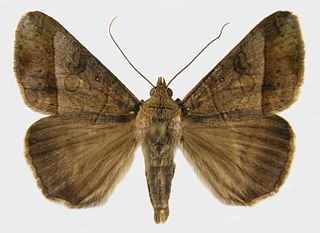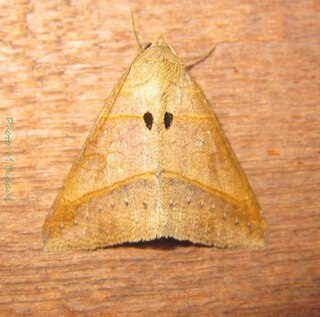
Mocis frugalis, the sugarcane looper, is a moth of the family Erebidae. The species was first described by Johan Christian Fabricius in 1775. It is found in several parts of the world, including India, Sri Lanka, West African countries and other Oriental regions. The adult is a fruit piercer and a major pest of crops.

Tigrioides alterna is a moth of the family Erebidae first described by Francis Walker in 1854. It is found in Australia.

Chrysodeixis is a genus of moths of the family Noctuidae described by Jacob Hübner in 1821.

Mocis is a genus of moths in the family Erebidae. The genus was erected by Jacob Hübner in 1823.

Chrysodeixis includens, the soybean looper, is a moth of the family Noctuidae. It is known as falso medidor in north-eastern Mexico. It is found from southern Quebec and southern Ontario through the eastern and southern part of the United States to Central America and South America, the Antilles and the Galápagos Islands. It is known to be migratory. The species was first described by Francis Walker in 1858.

Mocis disseverans, the yellow mocis moth, is a moth of the family Erebidae. It is found in the Caribbean and parts of the southern United States, including Mississippi, Florida and Texas.

Mocis repanda, the striped grass looper, is a species of moth of the family Erebidae. It was described by Johan Christian Fabricius in 1794. It is found in Central America and the Caribbean, including Cuba, the Dominican Republic, Guadeloupe, Guatemala, Jamaica, Puerto Rico and Saint Thomas. Strays can be found in the United States, up to southern Texas as well as subtropical Africa south of the Sahara, including the islands of the Indian Ocean.

Mocis latipes, the small mocis moth or striped grass looper, is a species of moth of the family Erebidae. It is found from North America (from southern Ontario and Quebec to Florida, west to Arizona, north to Minnesota and south through Central to South America.

Mocis conveniens, the pale brown lines, is a moth of the family Erebidae.
Mocis laxa is a species of moth of the family Erebidae. It is found in China, India (Sikkim) and Bangladesh.
Mocis mutuaria is a species of moth of the family Erebidae. It is found in the Democratic Republic of Congo, Kenya, Madagascar, Malawi, Mozambique, Namibia, Nigeria, Rwanda, South Africa, Tanzania, Uganda, Zambia and Zimbabwe.
Anomis combinans, the yellow-banded semi-looper moth, is a moth of the family Erebidae. The species was first described by Francis Walker in 1858. It is found in Australia, Sri Lanka, Borneo, New Guinea, Malaysia and Timor.








